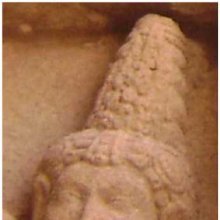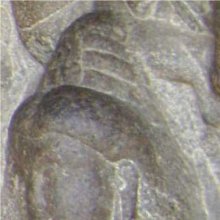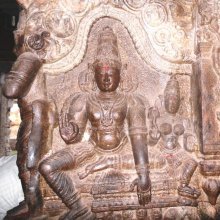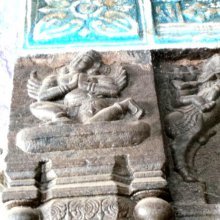Shiras, Śiras, Siro, Shirash: 26 definitions
Introduction:
Shiras means something in Buddhism, Pali, Hinduism, Sanskrit, the history of ancient India, biology, Tamil. If you want to know the exact meaning, history, etymology or English translation of this term then check out the descriptions on this page. Add your comment or reference to a book if you want to contribute to this summary article.
The Sanskrit term Śiras can be transliterated into English as Siras or Shiras, using the IAST transliteration scheme (?).
Images (photo gallery)
(+181 more images available)
In Hinduism
Ayurveda (science of life)
Source: Cogprints: Concepts of Human Physiology in AyurvedaŚiras (शिरस्, “head”) is the region where all ‘Prāṇas’ (most vital entities) are situated and all sensory and motor activities are controlled from. That is why ‘Head’ is called the ‘Most important organ’ among all parts of the body (Caraka-saṃhitā Sūtrasthāna. 17/12). It is described that all sensory and motor organs along with their ‘Prāṇavaha Srotāṃsi’, are connected to the brain in a fashion that is similar to the connections between the sunrays and the Sun. (Ca. Si. 9/4). Bhela has explained that the mind is situated in between the head and palate. The efficiency of mind is beyond any other sensory or motor organ (Bh. Ci. 8/2-3).

Āyurveda (आयुर्वेद, ayurveda) is a branch of Indian science dealing with medicine, herbalism, taxology, anatomy, surgery, alchemy and related topics. Traditional practice of Āyurveda in ancient India dates back to at least the first millenium BC. Literature is commonly written in Sanskrit using various poetic metres.
Natyashastra (theatrics and dramaturgy)
Source: Wisdom Library: Nāṭya-śāstra1) Śiras (शिरस्) refers to “head”. It is one of the six major limbs (aṅga) used in dramatic performance, according to the Nāṭyaśāstra chapter 8. With these limbs are made the various gestures (āṅgika), which form a part of the histrionic representation (abhinaya).
There are thirteen different ‘movements of the head (śiras)’ defined:
- Ākampita,
- Kampita,
- Dhuta,
- Vidhuta,
- Parivāhita,
- Udvāhita,
- Avadhuta,
- Añcita,
- Nihañcita,
- Parāvṛtta,
- Utkṣipta,
- Adhogata,
- Lolita.
2) According to the Nāṭyaśāstra chapter 19, śiras, as the “head register”, refers to a type of ‘vocal representation’ (vācika), which is used in communicating the meaning of the drama and calling forth the sentiment (rasa). Accordingly, to call a person staying at a distance, the voice should proceed from the head register (śiras).
Source: Shodhganga: The significance of the mūla-beras (natya)Śiras (शिरस्, “head”) refers to one of the seven “major limbs” (aṅga), which represents a division of Āṅgikābhinaya (gesture language of the limbs) as used within the classical tradition of Indian dance and performance, also known as Bharatanatyam.—Āṅgika-abhinaya is the gesture language of the limbs. Dance is an art that expresses itself through the medium of body, and therefore, āṅgikābhinaya is essential for any dance and especially for any classical dance of India. Aṅgas or major limbs include the head (viz., Śiras), hands, chest, sides, waist, and feet; at times the neck is also used as a separate limb.

Natyashastra (नाट्यशास्त्र, nāṭyaśāstra) refers to both the ancient Indian tradition (shastra) of performing arts, (natya—theatrics, drama, dance, music), as well as the name of a Sanskrit work dealing with these subjects. It also teaches the rules for composing Dramatic plays (nataka), construction and performance of Theater, and Poetic works (kavya).
Pancaratra (worship of Nārāyaṇa)
Source: archive.org: Isvara Samhita Vol 5Śiras (शिरस्) or Śiromudrā is the name of a mudrā described in the Īśvarasaṃhitā 24.21-23.—Accordingly, “Two fingers beginning with the thumb and ending with the little finger, when formed separately into a casket with space in between, shall be in the small finger and other would respectively be the mudrās of śiras, śikhā, kavaca, (tanutrāt), protecting the body, astra and netra)”. Mūdra (e.g., Śiras-mudra) is so called as it gives joy to the tattvas in the form of karman for those who offer spotless worship, drive out the defects which move about within and without and sealing up of what is done.

Pancaratra (पाञ्चरात्र, pāñcarātra) represents a tradition of Hinduism where Narayana is revered and worshipped. Closeley related to Vaishnavism, the Pancaratra literature includes various Agamas and tantras incorporating many Vaishnava philosophies.
Vastushastra (architecture)
Source: OpenEdition books: Architectural terms contained in Ajitāgama and RauravāgamaŚiras (शिरस्) refers to “- 1. roof (= śikhara) §§ 3.27; 4.18. - 2. coping of a wall (Rau) § 5.8. - 3. crowning of an arch (Aj) § 3.28. - 4. head of a stone (Aj) § 2.II.”.—(For paragraphs cf. Les enseignements architecturaux de l'Ajitāgama et du Rauravāgama by Bruno Dagens)

Vastushastra (वास्तुशास्त्र, vāstuśāstra) refers to the ancient Indian science (shastra) of architecture (vastu), dealing with topics such architecture, sculpture, town-building, fort building and various other constructions. Vastu also deals with the philosophy of the architectural relation with the cosmic universe.
Shaktism (Shakta philosophy)
Source: Google Books: ManthanabhairavatantramŚiras (शिरस्) refers to one of the eight sacred fields (kṣetra), according to the Ṣaṭsāhasrasaṃhitā, an expansion of the Kubjikāmatatantra: the earliest popular and most authoritative Tantra of the Kubjikā cult.—Accordingly, “The man of knowledge should mark the sacred fields located in the towns. [...] Now listen (to how it is) in the home. [...] Starting with the dish in due order, one should not touch these with one's feet, if one wants the best for oneself. One should stay far away from a broom and the wind produced by a winnowing fan. Obstacles (vighna), Siddhas and Yoginīs that have penetrated the wind enter the adept having identified (his) weak spot, and lay hold of the best (within him) for no reason. (The adept) abides in (each) place in the (eight) sacred fields, (namely) Gaṇikā, Śiras, Kālī, Kāla, Ālaya, Śiva, Kāliñjara, and Mahākāla”.

Shakta (शाक्त, śākta) or Shaktism (śāktism) represents a tradition of Hinduism where the Goddess (Devi) is revered and worshipped. Shakta literature includes a range of scriptures, including various Agamas and Tantras, although its roots may be traced back to the Vedas.
Shaivism (Shaiva philosophy)
Source: SOAS University of London: Protective Rites in the Netra TantraŚiras (शिरस्) refers to the “summit”, according to the Netratantra of Kṣemarāja: a Śaiva text from the 9th century in which Śiva (Bhairava) teaches Pārvatī topics such as metaphysics, cosmology, and soteriology.—Accordingly, [verse 2.28cd-33]—“Now, I shall explain the limbs of the mantra, with which, tied together, he achieves perfection. The hṛdayamantra, [which] confers all perfections, is the letter that terminates in the middle [j], followed by the fifth sovereign vowel [u], and summits with the conclusion of wind (prabhañjana-anta-śiras) [ṃ]. The śiras is terminal soma [v] joined with that from anala [y] and yoked with oṃ. [...]”.

Shaiva (शैव, śaiva) or Shaivism (śaivism) represents a tradition of Hinduism worshiping Shiva as the supreme being. Closely related to Shaktism, Shaiva literature includes a range of scriptures, including Tantras, while the root of this tradition may be traced back to the ancient Vedas.
Gitashastra (science of music)
Source: Shodhganga: Elements of Art and Architecture in the Trtiyakhanda of the Visnudharmottarapurana (gita)Śiras (शिरस्, “head”) refers to one of the three kinds of sthāna (the organs of utterance), according to the Viṣṇudharmottarapurāṇa, an ancient Sanskrit text which (being encyclopedic in nature) deals with a variety of cultural topics such as arts, architecture, music, grammar and astronomy.—During the practise of Vocal Music, the proper production of the concerned sound is always considered as very important. Sthāna or ucchāraṇasthāna is the place of articulation of sound. Bhattojidīkṣita in his Siddhāntakaumudī said about ten kinds of sthāna (i.e., the organs of utterance), e.g., śiras (i.e., head).
Gitashastra (गीतशास्त्र, gītaśāstra) refers to the ancient Indian science of Music (gita or samgita), which is traditionally divided in Vocal music, Instrumental music and Dance (under the jurisdiction of music). The different elements and technical terms are explained in a wide range of (often Sanskrit) literature.
Yoga (school of philosophy)
Source: ORA: Amanaska (king of all yogas): A Critical Edition and Annotated Translation by Jason BirchŚiras (शिरस्) refers to the “head”, according to the Mataṅgapārameśvaratantra (Mataṅgapārameśvara’s Yogapāda) verse 2.23-27.—Accordingly, while discussing ancillary and seated poses in Yoga: “[...] His head (śiras) should always be upright. His gaze is towards heaven and earth, and its support is the tip of the nose. His eyes are slightly closed and he does not touch the teeth [of the upper jaw] with those [of the lower, nor] with the tip of his tongue which is located on the middle of the palate. O great sage, [this] Karaṇa has been explained fully and at length in regard to the path of Yoga”.

Yoga is originally considered a branch of Hindu philosophy (astika), but both ancient and modern Yoga combine the physical, mental and spiritual. Yoga teaches various physical techniques also known as āsanas (postures), used for various purposes (eg., meditation, contemplation, relaxation).
In Buddhism
Mahayana (major branch of Buddhism)
Source: Wisdom Library: Maha Prajnaparamita SastraŚiras (शिरस्) refers to the “head”, according to Mahāprajñāpāramitāśāstra (chapter 41).—Accordingly, “[The eighteen āveṇika-dharmas (‘special attributes’)]— [...] (10). The Buddha has no loss of wisdom.—He has no loss of wisdom.—[...] Moreover, since his first production of the mind of awakening (prathama-cittotpāda) and for innumerable and incalculable periods (asaṃkhyeyakalpa), the Buddha has accumulated all the wisdoms and, in accordance with his high resolution (adhyāśaya), he has sacrificed his head (śiras), his eyes (nayana), his marrow (majjā) and his skull (mastaka), he has given all his inner and outer possessions, he has entered into fire, he has thrown himself down from mountains, he has flayed his skin, he has nailed his body, etc.; there is no suffering that he has not endured, careful to accumulate wisdom. This is why he has no loss of wisdom. [...]”.

Mahayana (महायान, mahāyāna) is a major branch of Buddhism focusing on the path of a Bodhisattva (spiritual aspirants/ enlightened beings). Extant literature is vast and primarely composed in the Sanskrit language. There are many sūtras of which some of the earliest are the various Prajñāpāramitā sūtras.
Tibetan Buddhism (Vajrayana or tantric Buddhism)
Source: Brill: Śaivism and the Tantric Traditions (tantric Buddhism)Śiras (शिरस्) refers to the “head”, according to Kuladatta’s Kriyāsaṃgrahapañjikā, a text within Tantric Buddhism representing a construction manual for monasteries.—Accordingly, [nimittokti section of chapter 3]—“If someone, either the Tantric officiant, a craftsman [involved in the rite], the donor or his officials scratches his head (śiras-kaṇḍūyamāna) [in the site for a monastery etc.], then there is an extraneous thing [that causes a calamity at a depth of] the full height of a man underground”.
Source: OSU Press: Cakrasamvara SamadhiŚiras (शिरस्) refers to the “head” and is associated with the syllable puṃ, according to the Cakrasaṃvara Samādhi [i.e., Cakrasamvara Meditation] ritual often performed in combination with the Cakrasaṃvara Samādhi, which refers to the primary pūjā and sādhanā practice of Newah Mahāyāna-Vajrayāna Buddhists in Nepal.—Accordingly, “[Do caturviṃśati-aṅga nyāsa; Touch twenty-one parts of one’s body with right middle finger, and recite seed syllables] ... Puṃ on the head (puṃ śirasi)”.

Tibetan Buddhism includes schools such as Nyingma, Kadampa, Kagyu and Gelug. Their primary canon of literature is divided in two broad categories: The Kangyur, which consists of Buddha’s words, and the Tengyur, which includes commentaries from various sources. Esotericism and tantra techniques (vajrayāna) are collected indepently.
India history and geography
Source: Shodhganga: A translation of Jhaverchand Meghanis non translated folk talesShiro refers to “A sweet item of food made of wheat flour, ghee and sugar”.—It is defined in the glossary attached to the study dealing with Gujarat Folk tales composed by Gujarati poet Jhaverchand Meghani (1896-1947)

The history of India traces the identification of countries, villages, towns and other regions of India, as well as mythology, zoology, royal dynasties, rulers, tribes, local festivities and traditions and regional languages. Ancient India enjoyed religious freedom and encourages the path of Dharma, a concept common to Buddhism, Hinduism, and Jainism.
Biology (plants and animals)
Source: Google Books: CRC World Dictionary (Regional names)Shiras in India is the name of a plant defined with Albizia odoratissima in various botanical sources. This page contains potential references in Ayurveda, modern medicine, and other folk traditions or local practices It has the synonym Acacia lomatocarpa DC. (among others).
Example references for further research on medicinal uses or toxicity (see latin names for full list):
· Research Journal of Medicinal Plant (2007)
· Supplementum Plantarum (1781)
· London Journal of Botany (1844)
· Chem. Pharm. Bull.
· Species Plantarum (1753)
· Revisio Generum Plantarum (1891)
If you are looking for specific details regarding Shiras, for example pregnancy safety, chemical composition, diet and recipes, side effects, extract dosage, health benefits, have a look at these references.

This sections includes definitions from the five kingdoms of living things: Animals, Plants, Fungi, Protists and Monera. It will include both the official binomial nomenclature (scientific names usually in Latin) as well as regional spellings and variants.
Languages of India and abroad
Pali-English dictionary
Source: BuddhaSasana: Concise Pali-English Dictionarysiro : is the form taken by sira in cpds.

Pali is the language of the Tipiṭaka, which is the sacred canon of Theravāda Buddhism and contains much of the Buddha’s speech. Closeley related to Sanskrit, both languages are used interchangeably between religions.
Sanskrit dictionary
Source: DDSA: The practical Sanskrit-English dictionaryŚiras (शिरस्).—n. [śṝ-asun nipātaḥ Uṇādi-sūtra 4.193]
1) The head; शिरसा श्लाघते पूर्वं (śirasā ślāghate pūrvaṃ) (guṇaṃ) परं (paraṃ) (doṣaṃ) कण्ठे नियच्छति (kaṇṭhe niyacchati) Subhās.
2) Skull.
3) A peak, summit, top (as of a mountain); हिमगौरैरचलाधिपः शिरोभिः (himagaurairacalādhipaḥ śirobhiḥ) Kirātārjunīya 5.17; Śiśupālavadha 4.54.
4) The top of a tree.
5) The head or top of anything; तेनाहृतो महातालो वेपमानो बृहच्छिराः (tenāhṛto mahātālo vepamāno bṛhacchirāḥ) Bhāgavata 1.15.33; शिरसि मसीपटलं दधाति दीपः (śirasi masīpaṭalaṃ dadhāti dīpaḥ) Bv.1.74.
6) Pinnacle, acme, highest point.
7) Front, forepart, van (as of an army); पुत्रस्य ते रणशिरस्ययमग्रयायी (putrasya te raṇaśirasyayamagrayāyī) Ś.7.26; Uttararāmacarita 5.3.
8) Chief, principal, head (usually at the end of comp.).
9) Name of the verse in the गायत्री (gāyatrī) (from āpo jyotiḥ to svarom); cf. T. Ar.1.27; Bhāg 5.9.5.
Source: Cologne Digital Sanskrit Dictionaries: Shabda-Sagara Sanskrit-English DictionaryŚiras (शिरस्).—n.
(-raḥ) 1. The head. 2. The skull. 3. The top of a tree. 4. A summit, a peak. 5. The van of an army. 6. Chief, principal, head. E. śri to honour, in the passive form, to be honoured, (by the other members,) asun Unadi aff., and the form irr.; or śṝasun ni0 .
Source: Cologne Digital Sanskrit Dictionaries: Benfey Sanskrit-English DictionaryŚiras (शिरस्).— (for original śaras, cf. Zend. śara, and śīrṣa), n. (the base of some cases is optionally śīrṣan, i. e. śiras + an), 1. The head, [Pañcatantra] iii. [distich] 193; śirasā pra-ṇi-pat, To reverence by inclining one’s head, [Vikramorvaśī, (ed. Bollensen.)] 3, 12; śirasā kṛ, To bear on one’s head, Böhtl. Ind. Spr. 1847. 2. The top of a mountain, [Kirātārjunīya] 5, 17; of a tree. 3. Chief, principal.
Source: Cologne Digital Sanskrit Dictionaries: Cappeller Sanskrit-English DictionaryŚiras (शिरस्).—[neuter] head, top, point, summit, fore-part, front; yuddhasya an. — Instr. [with] kṛ, dhṛ, etc. bear on the head i.e. esteem highly, honour, respect.
Source: Cologne Digital Sanskrit Dictionaries: Monier-Williams Sanskrit-English Dictionary1) Śiras (शिरस्):—n. ([probably] originally śaras = karas; and connected with karaṅka q.v.) the head, skull ([accusative] with √dā, ‘to give up one’s head id est. life’; with √dhṛ, or √vah, ‘to hold up one’s head, be proud’; with [Causal] of √vṛt or with upa-√sthā, ‘to hold out the head’, ‘acknowledge one’s self guilty’ See śiropasthāyin; [instrumental case] with √grah, √dhā, √dhṛ, vi-√dhṛ, √bhṛ, √vah, or √kṛ, ‘to hold or carry or place on the head, receive deferentially’; [instrumental case] with √gam, abhi-√gam, pra-√grah, √yā, pra-ṇam [√nam], ni-√pat, pra-ṇi-√pat, ‘to touch with the head, bow or fall down before’; [locative case] with √kṛ or ni-√dhā, ‘to place on one’s head’; [locative case] with √sthā, ‘to be on or stand over a person’s head, stand far above [gen.]’), [Ṛg-veda] etc. etc.
2) the upper end or highest part of anything, top, peak, summit, pinnacle, acme, [Mahābhārata; Kāvya literature] etc.
3) the forepart or van (of an army), [Śiśupāla-vadha]
4) the beginning (of a verse), [Varāha-mihira’s Bṛhat-saṃhitā]
5) (ifc.) the head, leader, chief, foremost, first (of a class), [Bhāgavata-purāṇa]
6) Name of the verse āpo jyotir āpo mṛtam, [Baudhāyana-dharma-śāstra; Viṣṇu-smṛti, viṣṇu-sūtra, vaiṣṇava-dharma-śāstra] etc.
7) of a Sāman (also with indrasya), [Ārṣeya-brāhmaṇa; Lāṭyāyana]
8) of a mountain, [Buddhist literature]
9) cf. śīrṣan; [Greek] κέρας, κάρη etc.; [Latin] cerebrum for ceresrum, cornu; [German] hirni, Hirn; [English] horn.
10) Śiraś (शिरश्):—[from śiras] in [compound] for śiras.
Source: Cologne Digital Sanskrit Dictionaries: Monier-Williams Sanskrit-English DictionaryŚiraḥ (शिरः):—[from śiras] in [compound] for śiras.
Source: Cologne Digital Sanskrit Dictionaries: Monier-Williams Sanskrit-English DictionaryŚiro (शिरो):—[from śiras] in [compound] for śiras.
Source: Cologne Digital Sanskrit Dictionaries: Yates Sanskrit-English DictionaryŚiras (शिरस्):—(raḥ) 5. n. The head; top of a tree; van of an army; a chief.
Source: DDSA: Paia-sadda-mahannavo; a comprehensive Prakrit Hindi dictionary (S)Śiras (शिरस्) in the Sanskrit language is related to the Prakrit word: Sira.
[Sanskrit to German]
Sanskrit, also spelled संस्कृतम् (saṃskṛtam), is an ancient language of India commonly seen as the grandmother of the Indo-European language family (even English!). Closely allied with Prakrit and Pali, Sanskrit is more exhaustive in both grammar and terms and has the most extensive collection of literature in the world, greatly surpassing its sister-languages Greek and Latin.
Tamil dictionary
Source: DDSA: University of Madras: Tamil LexiconŚiras (ஶிரஸ்) noun < śiras. Head. See சிரசு. [sirasu.]
Tamil is an ancient language of India from the Dravidian family spoken by roughly 250 million people mainly in southern India and Sri Lanka.
See also (Relevant definitions)
Starts with (+80): Shiracchedana, Shiracchedanaka, Shirahkanduya, Shirahkapalin, Shirahkriya, Shirahpada, Shirahphala, Shirahpida, Shirahpitha, Shirahpradana, Shirahpranama, Shirahpravarana, Shirahprishtha, Shirahpushpa, Shirahshula, Shirahstha, Shirahsthana, Shirahsthita, Shirambhoja, Shirasa.
Ends with (+123): Abhishekardrashiras, Abhishiras, Abhrashiras, Adhahshiras, Adhashshiras, Adhishiras, Ajishiras, Amhrishiras, Anantashiras, Anushtupshiras, Apashiras, Ardhacandrashiras, Ardhashiras, Arkashiras, Ashiras, Ashvashiras, Atharvanashiras, Atharvashiras, Avakashiras, Avakshiras.
Full-text (+596): Shirahpida, Shiroroga, Shirosthi, Shiroruh, Shirahphala, Siroruha, Shirodhi, Shirashcheda, Shirovalli, Shirahpranama, Shirovritta, Shiroveshtana, Shiromarman, Shiroveshta, Shirahpitha, Bhujashiras, Shirastra, Shirashchedana, Ashirahsnana, Catikashiras.
Relevant text
Search found 82 books and stories containing Shiras, Shirah, Shirash, Shiro, Śiraḥ, Sirah, Śiras, Śiraś, Siras, Śiro, Siro; (plurals include: Shirases, Shirahs, Shirashes, Shiros, Śiraḥs, Sirahs, Śirases, Śiraśs, Sirases, Śiros, Siros). You can also click to the full overview containing English textual excerpts. Below are direct links for the most relevant articles:
Rig Veda (translation and commentary) (by H. H. Wilson)
Sushruta Samhita, Volume 6: Uttara-tantra (by Kaviraj Kunja Lal Bhishagratna)
Chapter XXV - Symptoms of diseases of the head < [Canto I - Shalakya-tantra (ears, eyes, nose, mouth and throat)]
Chapter XXVI - Treatment of diseases of the head < [Canto I - Shalakya-tantra (ears, eyes, nose, mouth and throat)]
Chapter XXIV - Symptoms and treatment of Catarrh < [Canto I - Shalakya-tantra (ears, eyes, nose, mouth and throat)]
Garga Samhita (English) (by Danavir Goswami)
Verses 2.22.21-22 < [Chapter 22 - The Rāsa-dance Pastime]
Verse 6.10.19 < [Chapter 10 - In the Description of the Gomatī River, the Glories of Cakra-tīrtha]
Verse 1.14.56 < [Chapter 14 - The Liberation of Śakaṭāsura and Tṛṇāvarta]
Hari-bhakti-kalpa-latikā (by Sarasvati Thkura)
Text 3 < [Second Stabaka]
Vakyapadiya of Bhartrihari (by K. A. Subramania Iyer)
Verse 3.13.30 < [Book 3 - Pada-kāṇḍa (13): Liṅga-samuddeśa (On Gender)]
Kashyapa Shilpa-shastra (study) (by K. Vidyuta)
7. The Shapes and Embellishments of the Gopuras < [Chapter 5 - Gopura Lakṣaṇa]
6. Components in the Storeys of the Gopuras < [Chapter 5 - Gopura Lakṣaṇa]
8. Śālā, Sabhā and Mālikā-kāra Lakṣaṇas < [Chapter 5 - Gopura Lakṣaṇa]
Related products







